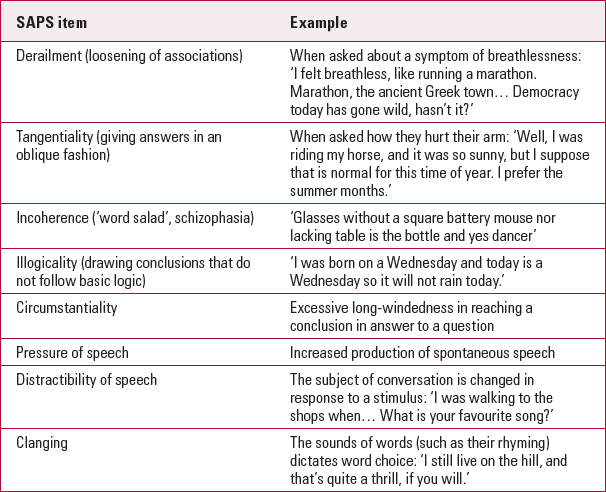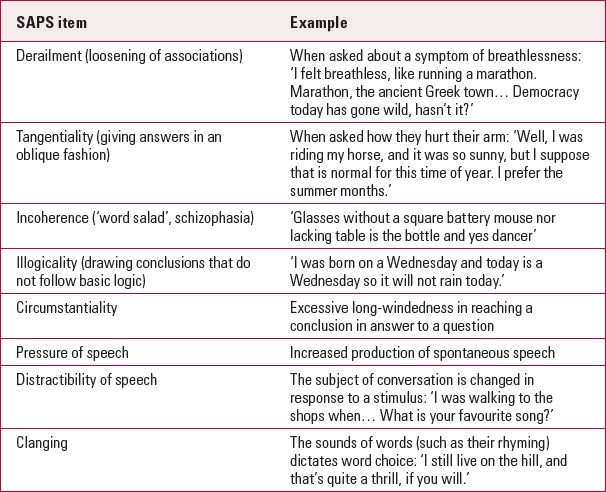The systematised study of psychopathology arose out of wider developments in psychology and in philosophy, and has been heavily influenced by traditions in German academia from the 19th century. Specifically, Karl Jaspers imported Kantian ideas of knowledge and sensory experience, its ‘form’ and ‘content’, into his psychopathology. As psychiatry trainees and medical students are aware, the content of a particular experience (for example, that I am a terrorist or a paedophile) can occur in a variety of differently structured abnormal experiences, or forms. It could be a delusional belief, an obsessional rumination, an overvalued depressive guilty cognition or the content of an auditory hallucination. Traditionally, form is useful for diagnosis and is thought to be more culturally invariant, and the precise content of a given psychopathological experience is of less relevance diagnostically and may change with time and with geography. However, the content can be very important in terms of the patient's distress, and the psychiatrist's understanding of the behaviour and their assessment of the risks for the patient. This distinction, between form and content, is carried over to when the psychiatrist assesses and examines the speech of patients, and one of the disorders of the form of speech is referred to as formal thought disorder. This term is somewhat confusing and is based on the assumption that a disorder of speech reflects a disorder of thought, which may not be the case. Hence, in terms of completing a mental state examination, thought disorder is classified under ‘speech’, whereas symptoms included under ‘thoughts’ would be the psychopathological forms of delusion, obsession and overvalued ideas.
Formal thought disorder (FTD) describes abnormal features of speech that are most commonly associated with schizophrenia, but are also seen in affective psychoses, non-psychotic illness, drug intoxication and organic brain disorders. Individuals with FTD can experience disorders of conceptual or abstract thinking (Reference Casey and KellyCasey 2007) due to neuropsychological dysfunction, particularly in executive ability (Reference Barrera, McKenna and BerriosBarrera 2005). Tools developed to assess FTD in individuals with schizophrenia identify some of the precise features that may be present in FTD.
Assessment and clinical significance of FTD
Assessment
Andreasen's Scale for the Assessment of Positive Symptoms (SAPS) and Scale for the Assessment of Negative Symptoms (SANS) outline particular patterns of speech disorganisation that are seen in thought disorder (Reference Andreasen, Flaum and SwayzeAndreasen 1990). The signs of formal thought disorder that fulfil this item and can be useful to elicit clinically are: derailment; tangentiality; incoherence; illogicality; circumstantiality; pressure of speech; distractibility of speech; and clanging (Table 1). As well as these positive symptoms detailed in the SAPS, there exist a number of features of speech that can be found in negative formal thought disorder: loss of goal (an inability to complete an idea/sentence), poverty of speech and alogia are defined and described in the SANS. These terms are rather more precise and descriptive than some of those seen in some psychiatric textbooks and can be more useful in clinical practice.
TABLE 1 Examples of thought disorder items in the Scale for the Assessment of Positive Symptoms (SAPS)

Eliciting and identifying FTD depends on both the patient's subjective awareness of their disturbed thinking pattern, and/or the manifestation of abnormal thinking in detectably abnormal speech patterns. Positive FTD may be demonstrated through disorganised speech, and negative FTD through the limited production of speech and its paucity of content. FTD can be demonstrated through an individual's use of language, which may be analysed for abnormalities in the flow of speech, use of words and grammar, and an inability to conceptualise. Structured interviewing, such as through the use of the Schedules for Clinical Assessment in Neuropsychiatry (SCAN) (Reference Wing, Babor and BrughaWing 1990), can elicit some of the aforementioned speech perturbations that may be seen in FTD. In those at risk of psychosis, as defined by tools such as the Comprehensive Assessment of At-Risk Mental States (CAARMS) (Reference Yung, Yuen and McGorryYung 2005), ‘subjective thought disorder’ can often be elicited. Those who may be in the prodromal phase may report struggling with finding the right words, revert to using nonverbal language more often and demonstrate subtle echolalia.
Positive and negative FTD are described alongside other symptoms of schizophrenia in Liddle's classification of schizophrenia into three syndromes – psychomotor poverty, disorganisation and reality distortion (delusions and hallucinations) (Reference LiddleLiddle 1987). The symptoms belonging to the psychomotor poverty group (blunting of affect, poverty of speech and decreased spontaneous movement) align themselves with some of the features characteristic of individuals with negative FTD. In contrast, positive FTD falls into the disorganisation group of symptoms, which further includes inappropriate affect and poverty of content of speech.
Clinical significance
Although finer aspects of FTD and its pathophysiology remain to be elucidated, there is clear clinical value in identifying FTD in patients. Disorganised speech may be an early sign of relapse and predict a psychotic episode, and attenuated positive FTD symptoms are observed among patients with schizophrenia in whom there is no diagnostic FTD. Positive FTD therefore represents a continuous, rather than dichotomous, diagnostic variable, wherein severity of psychotic symptoms is positively correlated with severity of positive FTD. FTD may therefore act as a marker of psychotic proneness, thus screening for, and detection of, FTD is of clinical importance. FTD, when present, is a feature of early psychosis, and positive FTD is associated with greater severity of psychotic symptoms. Equally, negative FTD is a predictor of poor functional outcome (increased rate of relapse, longer hospital admissions, greater social isolation), thus early detection of FTD is important as a guide to wider prognosis and severity and to optimise relevant interventions.
Neuropsychology and neuroimaging in FTD
Acute episodes of FTD are likely to represent underlying neurocognitive deficits and a proneness to psychosis. FTD is thought to be due to impaired semantic processing (culminating in a loosening of associations) which does not remit on resolution of the FTD. FTD therefore functions as a marker of trait-level alterations to neurocircuits (including the frontotemporal network involved in semantic decision tasks (Reference Arcuri, Broome and GiampietroArcuri 2012)), which are the focus of current research into FTD. FTD is increasingly being considered a core cognitive symptom of psychosis. Current research aims to further our understanding of the pathophysiology of FTD, as well as its clinical significance.
Imaging studies of patients with schizophrenia have helped elucidate underlying pathophysiological brain structures, and this work extends to the study of FTD. In negative FTD, there are associated reductions in medial frontal/orbitofrontal cortical grey matter. In positive FTD, there is known to be differential activation of the right temporal cortex, which plays a role in language comprehension, as well as reductions in Wernicke's and Broca's areas. More recent work has identified concomitant striato-insular/precuneus reductions of functional activation, and frontocingular grey matter increases, to be strongly associated with negative FTD (Reference Palaniyappan, Mahmood and BalainPalaniyappan 2015). FTD is thus likely to be underpinned by changes in several macrocircuits, including those pertaining to semantic networks.
The frontotemporal network, which facilitates semantic decision tasks, has been found to be underactivated in schizophrenia patients with FTD (Reference Arcuri, Broome and GiampietroArcuri 2012). This manifests as impaired language processing and the production of incoherent speech. Rather than indicating structural damage to this network, the remission of FTD symptoms suggests instead that disorganisation of semantic memory structure, or altered access to semantic memory during FTD, may underlie FTD manifestation (Reference Tan, Neill and RossellTan 2015).
Greater FTD occurs when cognitive demands are increased, in keeping with the neurocognitive semantic model discussed above, but also when negative affective demands are increased. Those with greater affective reactivity in early psychosis have more positive FTD (Reference Minor, Marggraf and DavisMinor 2016). This correlates to poor real-world functioning, suggesting that affective reactivity may be a predictive marker of psychosis severity, and thus represent a therapeutic opportunity wherein emotion regulation strategies can be taught, so as to reduce long-term impairment.
Conclusions
Identification of FTD has been made possible through the development of validated screening tools, and it allows for the stratification of individuals with schizophrenia on the basis of the presence or absence of FTD, as well as the positive or negative nature of any thought disorder. There is as yet, however, little therapeutic implication for diagnosing FTD, although its importance has been recognised with regard to its impact on prognosis and likely disease severity. The appreciation and recognition of FTD by medical students and trainees is thus important when considering the intensity of service engagement and treatment that an individual may require. As our understanding of the underlying pathophysiological processes at play in FTD improves, potential therapeutic targets or strategies may emerge, improving outcomes and prognoses for individuals with FTD.




eLetters
No eLetters have been published for this article.